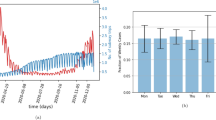Abstract
Following a study modelling the geographical spread of influenza in France, on the basis of population movements through the use of railroad data, we applied the same methodology on a European scale. We simulated an epidemic within a network of 9 European cities (Amsterdam, Berlin, Budapest, Copenhagen, London, Madrid, Milano, Paris, Stockholm), only taking into account regular between-cities air transport. Transportation data were obtained from the International Civil Aviation Organization (1991). The theoretical results show that the time lag for action is probably short (less than one month) after the first detection of an epidemic focus.
Similar content being viewed by others
References
Rvachev LA, Longini IM. A mathematical model for the global spread of influenza. Math Biosci 1985; 75: 1–22.
Flahault A, Letrait S, Blin P, Hazout S, Ménar ès J, Valleron AJ. Modelling the 1985 influenza epidemic in France. Stats Medic 1988; 7: 1147–1155.
Author information
Authors and Affiliations
Rights and permissions
About this article
Cite this article
Flahault, A., Deguen, S. & Valleron, AJ. A mathematical model for the European spread of influenza. Eur J Epidemiol 10, 471–474 (1994). https://doi.org/10.1007/BF01719679
Issue Date:
DOI: https://doi.org/10.1007/BF01719679




